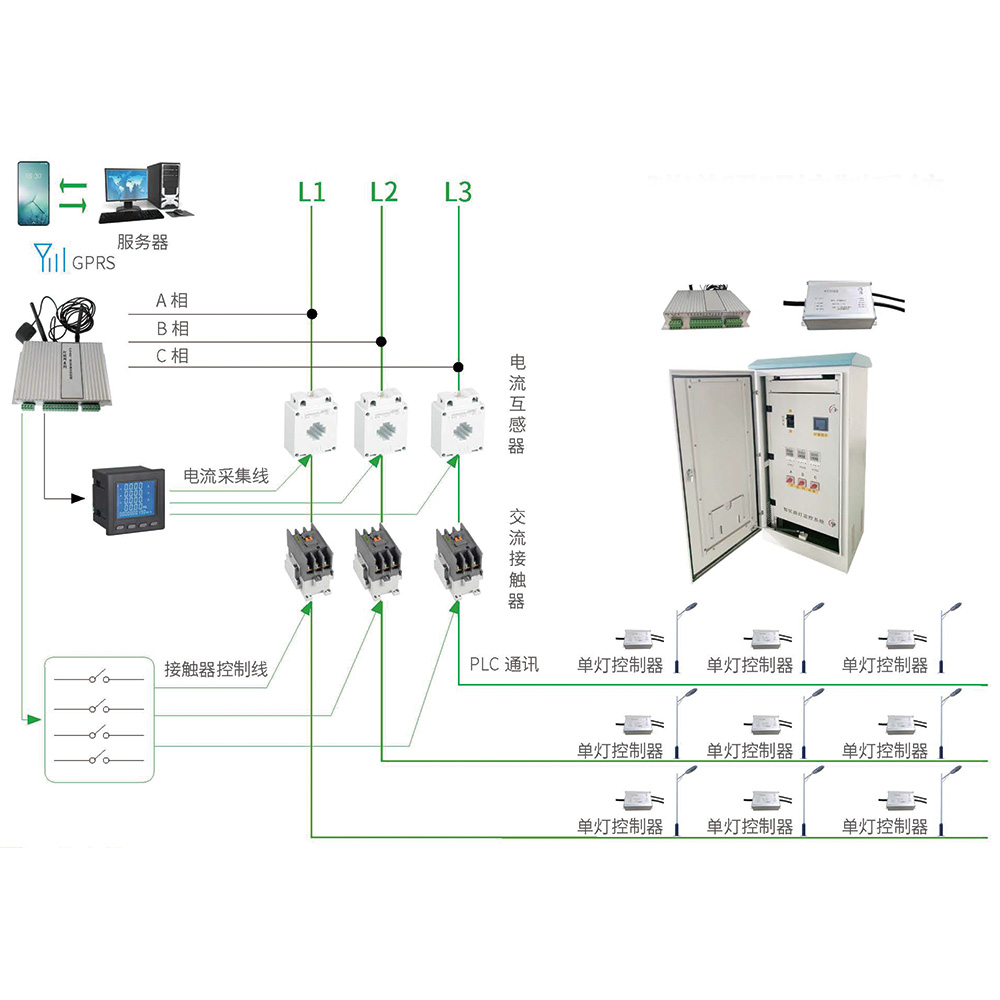1. Function Introduction
The street lamp distribution box is installed next to the street lamp to provide power for street lamp lighting and also to achieve on-demand lighting. This is the basic requirement of traditional distribution boxes. In the context of smart cities, these functions are far from meeting the needs of modern urban management. Therefore, based on market demand, Aiserfei Technology has developed an intelligent street light distribution box, which mainly achieves the following functions:
◆ Switching lights
The electrical box is equipped with a GPS module, which calculates the sunrise and sunset times every day to configure the lighting time
The built-in light sensor in the electrical box can turn on the lights according to the degree of darkness
◇ The electrical box is equipped with a concentrator module, which can remotely configure the on/off light time and preset multiple on/off light schemes
Measurement function
◇ Power consumption measurement function, the backend software calculates power consumption daily, generates monthly and annual reports, and provides data support for PPP projects.
◇ Extended function alarm function
The alarm function is the main feature of intelligent distribution boxes, which can inform relevant responsible persons of some events that occur in the box through SMS, eliminating the trouble of inspection.
◇ Extended function: Leakage alarm, the electrical box performs residual current detection on each power supply circuit it provides (detection threshold can be set). Once a leakage occurs in a circuit, it will automatically cut off the circuit and reflect it to the backend software, record it as an alarm event, and notify relevant personnel via SMS.
◇ Extended function: Cable anti-theft. Install cable anti-theft terminals at the end of each circuit to perform anti-theft monitoring on each cable. Once someone cuts the cable, the electrical box will respond to the backend software, record an alarm event, and notify relevant personnel via SMS.
◇ Extended function: Water overflow alarm. When the rainwater exceeds the foundation of the electrical box, in order to ensure electrical safety, the electrical box will automatically cut off the power supply of all circuits, which will be reflected in the background software, recorded as an alarm event, and notified to relevant personnel via SMS.
◇ Extended function: Door opening alarm. When someone opens the front or back door of the electrical box, the electrical box will respond to the backend software, record as an alarm event, and notify relevant personnel via SMS.
◇ Extended function: Phase loss alarm. When one phase of the three-phase power has no voltage, the electrical box will respond to the backend software, record it as an alarm event, and notify relevant personnel via SMS.
◇ Extended function: Power outage alarm. When the power box encounters a power outage, the situation will be reported to the backend software, recorded as an alarm event, and notified to relevant personnel via SMS.
◇ Extended function: AC contactor abnormal alarm. When the AC contactor operates abnormally (the suction is not closed, the release is not released, that is, the brightness during the day and the light is turned off at night), the electrical box will respond to the background software, record it as an alarm event, and notify relevant personnel via SMS. With such multiple protection distribution boxes supplying power to your streetlights, you can rest assured.
2. Dimming scheme for tunnel lights
Tunnel lighting is a necessary guarantee for ensuring driving safety and smooth traffic flow. Tunnel lighting has higher requirements for lighting, ensuring brightness, energy saving, and natural transition with the brightness outside the tunnel. This puts higher demands on the lighting control system. In 2006, the lighting systems of eight high-speed tunnels from Kunming to Qujing were upgraded. After the renovation, the comfort and safety of the lighting were greatly improved, resulting in good social benefits
3.485 Communication Plan
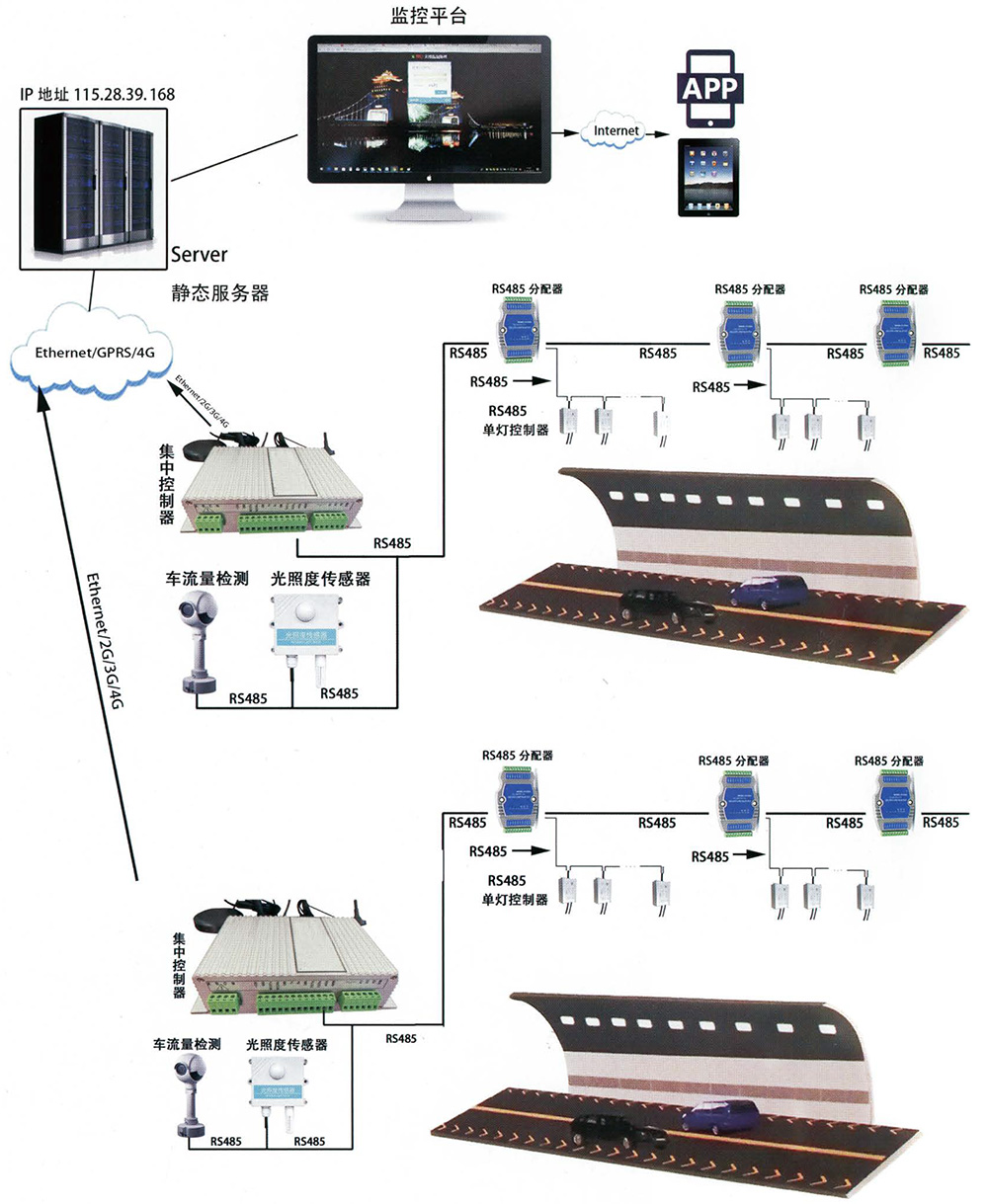
4. Dimming scheme for urban road lights
Urban Lighting Solution includes road lighting (streetlights) and landscape lighting (night scenes), which are not only important municipal infrastructure, but also an important symbol of urban construction level and city image. It is imperative to achieve Internet of Things control and intelligent management for urban lighting points that are diverse and extensive.
The CY_LAMPs_Monitor urban lighting IoT solution consists of a three-layer structure: an upper level control center (cloud platform), a middle level lighting centralized controller, and a lower level single lamp controller. The system is compatible with various communication methods, achieving full coverage and integration of lighting facilities throughout the city. Among them, GPRS/CDMA/4G public network or TCP/IP Internet communication is adopted for the first and second layers; 2、 The third layer adopts power line carrier or ZigBee/RF433 wireless short-range communication to achieve functions such as dimming, grouping, and parameter acquisition; The second layer centralized controller is installed in the street lamp distribution box, equipped with 16 switch output and input modules, for comprehensive monitoring of street lamp lines (including cable leakage protection, disconnection alarm, tripping, etc.), and connected to smart meters, light sensors, and lighting equipment through RS485. The central controller has a built-in GPS module to intelligently configure the on/off time of the lights. Users can easily operate the backend software or mobile APP to achieve centralized monitoring and unified management of street lamps and night scenes throughout the city, achieving the goal of intelligent urban lighting, energy conservation, and efficiency improvement. By adopting scientific and reasonable measures such as turning on and off lights, dimming, and variable power, energy savings can reach over 30%.
This solution also has functions such as asset management, work order management, energy consumption management, and vehicle management, making it the preferred choice for building smart lighting and upgrading monitoring systems in cities at all levels. Power line communication, also known as PLC, is an abbreviation for Power Line Communication in English. Power line carrier communication is a unique communication method in the power system, which refers to the technology of using existing power lines to transmit analog or digital signals at high speed through carrier communication. The biggest feature is that there is no need to rebuild the network, as long as there are wires, data transmission can be carried out
5. PLC Power Carrier Communication Scheme
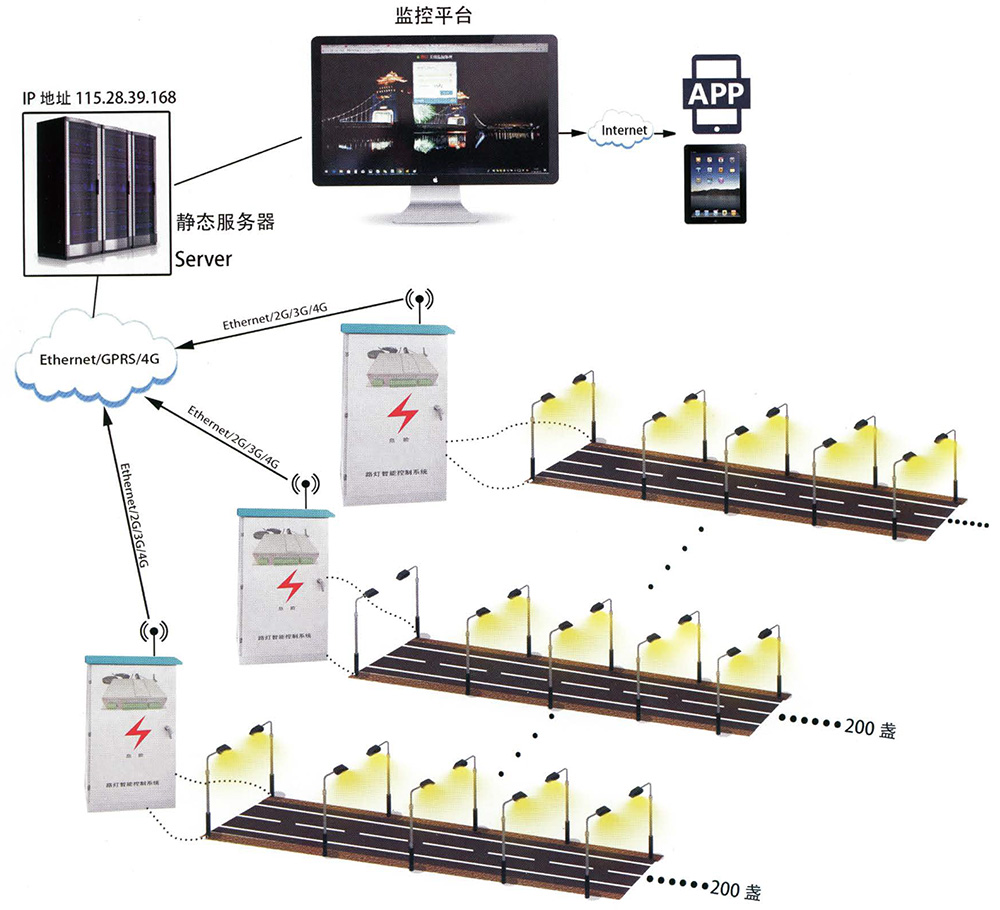
6. System functional characteristics
◇ 24/7 automatic monitoring
◇ Hardware structure diagram of power line carrier communication terminal
The monitoring range can reach several kilometers
After adding the automatic routing function, the monitoring range has doubled
Single lamp status detection: voltage, current, switch, temperature, etc
◇ Automatic reporting of single lamp fault status
◇ Energy saving control of lighting system
◇ Alarm for various faults or abnormal situations
Multiple alarm methods for users to choose from
◇ Send remote alarm information to the control center or on duty personnel's mobile phones
◇ Can be connected to emergency call systems such as 110
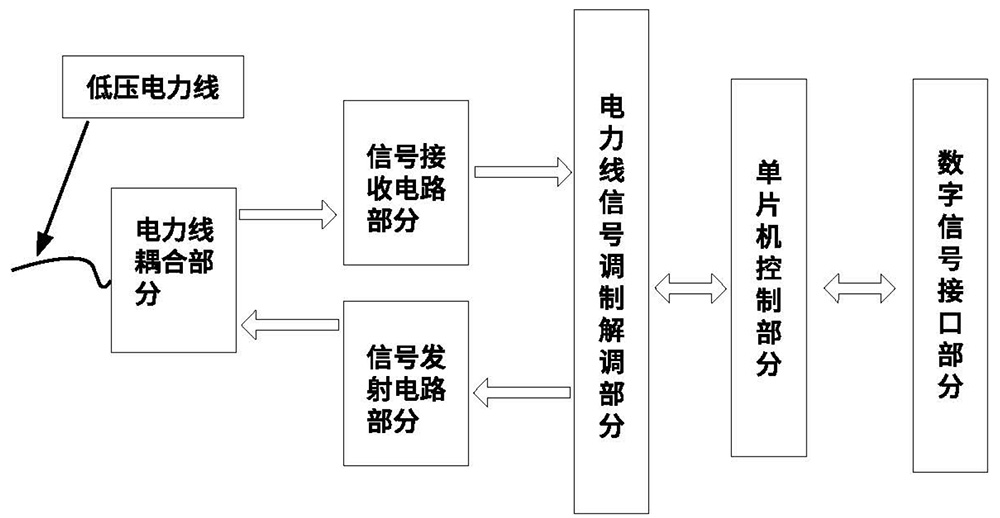
RF433 Wireless Communication Solution
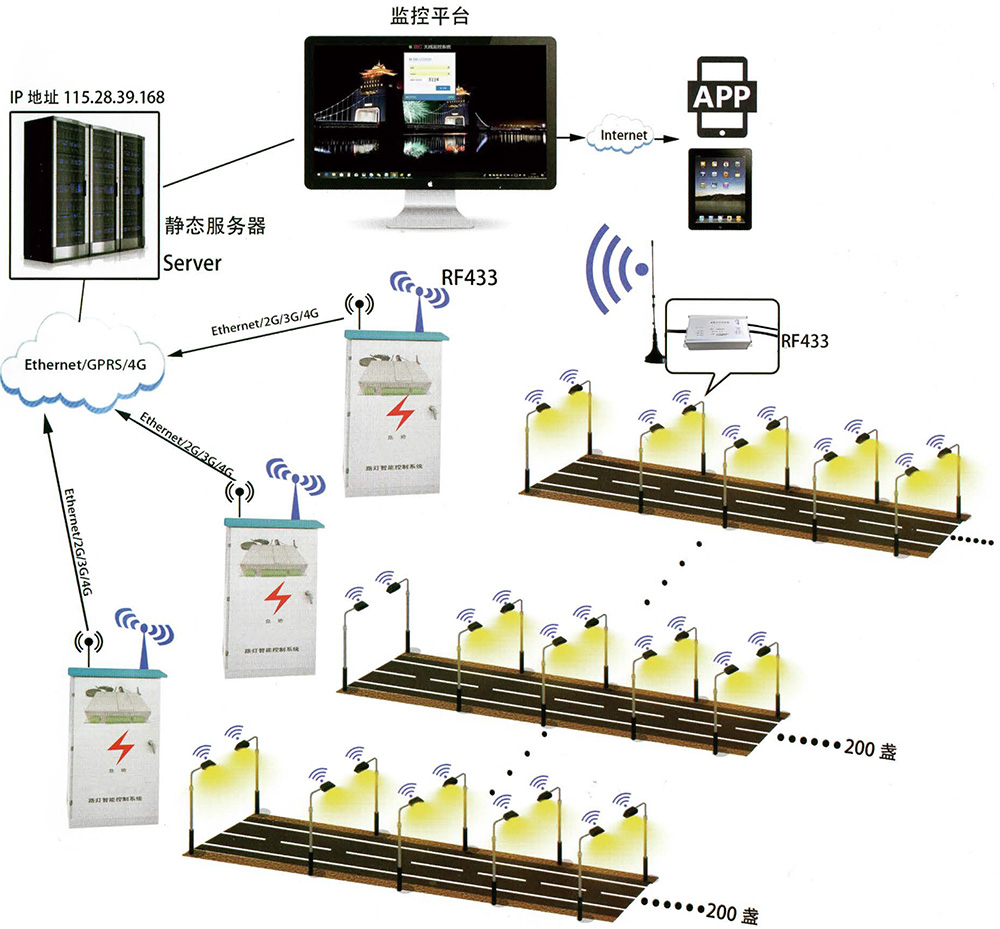
8. Precautions for selecting PLC
◇ No need to rebuild the network, as long as there are wires, data transmission can be carried out, undoubtedly becoming one of the best solutions for solving the data transmission of street lighting. At the same time, because data is only transmitted within the scope of the power system, remote control of street lamps can also be achieved by connecting to a PC through traditional networks and then controlling the street lamps. The cost of PLC modulation and demodulation modules is also much lower than that of wireless modules.
Compared to other wireless technologies, it has a faster transmission rate.
Distribution transformers have a blocking effect on power carrier signals, so power carrier signals can only be transmitted within one distribution transformer area;
There is significant signal loss (10 dB-30dB) between three-phase power lines. When the communication distance is very close, different phases may receive signals. Generally, power line carrier signals can only be transmitted on single-phase power lines;
Different signal coupling methods result in different losses of power carrier signals, with wire ground coupling and line neutral coupling being the coupling methods. Compared with the line to neutral coupling method, the line to ground coupling method reduces the loss of power carrier signals by more than ten dB. However, the line to ground coupling method is not applicable to power systems in all regions;
Power lines have inherent pulse interference. The AC power used includes 5OHz and 6OHz, with periods of 20ms and 16.7ms. In each AC cycle, there are two peaks, which will cause two pulse interferences. That is, there is a fixed 100Hz or 12OHz pulse interference on the power line, with an interference time of about 2ms. Therefore, the interference must be treated. There is a method of using waveforms to transmit data in a short period of time by passing through the zero crossing point, but due to the short zero crossing time, it is difficult to control the synchronization with AC waveforms in practical applications, and modern communication data frames are relatively long, making it difficult to apply;
Power lines cause high attenuation of carrier signals. When the load on the power line is heavy, the line impedance can reach below I ohms, causing high reduction of the carrier signal. In practical applications, when the power line is unloaded, point-to-point carrier signals can be transmitted for several kilometers.
Although technical issues can eventually be resolved and overcome over time, based on the current situation of broadband network construction in China, there is not enough time and space left for PLCs. Since 2000, major telecom operators have launched various broadband access services such as ADSL, fiber optic, and wireless networks on a large scale, leaving room for the survival of power line internet access, which has been continuously compressed by other access methods. PLC, apart from its application in remote meter reading, no longer has the grand promises it once had.
Power Cat is the latest application and development of power line carrier technology. The so-called Power Cat, also known as the "Power Network Bridge", is a device that modulates network signals onto wires and uses existing wires to solve network wiring problems. As a third-generation network transmission device born of technology, Power Cat is becoming popular worldwide with its unique advantages. Its working principle is to use wires to transmit high-frequency signals, load high-frequency signals carrying information onto current, and then use power transmission. The power network bridge that receives information then decomposes the high-frequency signals from the current, thereby realizing various applications such as internet access, making phone calls, watching IPTV, and using monitoring equipment without the need for rewiring.
The remote street lamp monitoring system utilizes power line carrier technology to connect the street lamp lighting system to an intelligent lighting system through existing power lines. This system can save electricity while ensuring road safety, extend the lifespan of lighting fixtures, and reduce operating and maintenance costs.





 Back
Back
